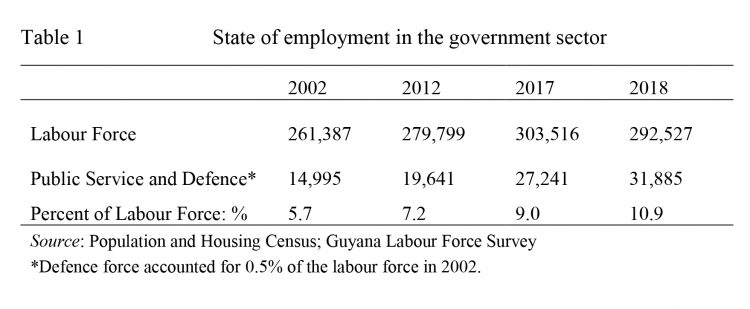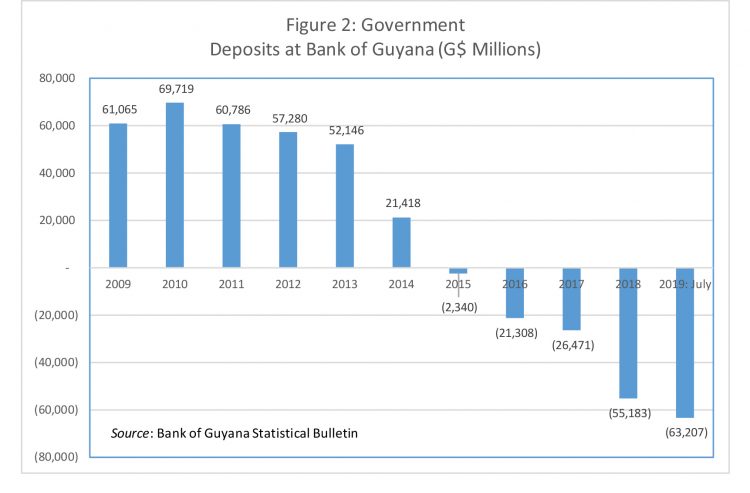If we want to say something about the future state of an event, we have to account for the initial conditions. Given that we live in a complex world, the outcomes often depend on the initial conditions. It is possible that one initial condition could produce multiple outcomes, making the task of prediction fraught with errors and pitfalls. In spite of the peril, I will argue that we should account for the state of the government sector at this point as we ponder the economic outcomes of oil revenues.
This is important because the oil revenues will directly flow to government, which will be responsible for distributing the monies to competing interests inside and perhaps outside Guyana. Therefore, the direction in which the government sector is heading in recent years will present helpful insights into how well the funds will be spent in the future. It is also important for pondering future political contestation between the PPPC and PNCR.
Of course, oil revenues will indirectly accrue to parts of the private sector. The oil companies need to outsource to local businesses such as accounting firms, transport businesses, engineering firms, catering businesses, information technology companies and so on. Exactly how much indirect funds accumulate to the non-governmental sector depends on the capacity of Guyanese businesses to supply the services and products in the short, medium and long term, as well as the government setting the enabling environment for business success. Presently there is a soft battle between the present administration and its supporters and the private sector. This soft battle is a residue from the political conflict that resulted from the 1997 general election and after.
The first chart tells a story about the consumption and investment decisions by the Guyana government over one decade – 2009 to 2018. It also shows the private sector’s investments in business activity for the same period. Everything is measured as a per cent of GDP. So, for example, in 2009 the government spent 14% of Guyana’s GDP in capital investments such as roads, bridges, buildings and other public goods. This aspect of spending is crucial for building the infrastructure necessary for the entire society. It is what generates sustained economic growth. The number fell to just 4% in 2015 but has recovered since. By end 2018, the government spent 9% of GDP on long-term projects, a rate that was still below that of 2009.
On the other hand, an upward trend line captures the increasing government consumption from 2009 to 2018. This includes spending on wages and salaries and other day-to-day government activities. This spending is not on public goods and infrastructure, but on current expenditures. If one wants to look at trends in jobs for the boys and girls, one would at least have to consider government consumption. In 2009, 18% of GDP was spent on short-term expenditures. This number went down in 2012 to 15% of GDP. It increased monotonically since then to reach 21% of GDP in 2018. This means that the government spends 12 percentage points more on short-sighted activities than on growth-augmenting long-term projects – perhaps because of the pressure on government to reward its base after winning the election.
Private sector investments, however, was moving in the wrong direction from 2009 to 2013 (see right axis of chart; bars). In 2009 the private sector invested in businesses at a rate of 16% of GDP, but this number fell to 11% of GDP in 2013. Something dramatic occurred starting from 2014. That something, of course, is the commencement of investments in the oil and gas sector. There was a dramatic turnaround in the private investment rate in 2014 amounting to 23% of GDP. This no doubt partly reflects the exploration investments in the oil and gas sector. By 2018, the rate of private investment rose to an astounding 41% of GDP. The precipitous increase in private investment is now paying off in higher GDP growth as I noted last week.
Let us now explore trends in employment in the public service. As I have written several times in the past, one of the primary purposes of politics in Guyana is to control the political party via the list system, stoke the strategic pro-ethnic voting, win control of government and then distribute patronage to primarily supporters, as well as some connected folks from the other side. I will write something on this in the future since the patronage formations of the PPP and PNC are very different with varying consequences.
Table 1 shows the number of workers in the public service in the years 2002, 2012, 2017 and 2018. These are the selected years chosen because they are the ones for which I could obtain data from published documents in the public domain. The table also presents the number of workers in the labour force and the percentage of the labour force accounted for by the public service plus defence.
As we can see, the employment level in the public service is on the rise, and substantially so. Since, I do not know the state of employment in 2015, I will not comment on whether there has been a dramatic increase from the PPP to the APNU+AFC period. However, the public service has increased by 62.3% since 2012, an increase that might seem dramatic since we are comparing 2012 with 2018. Nevertheless, the data is still consistent with my jobs-for-the-boys-and-girls thesis since the trend is upward. As the political contestation rises in the coming years, we can expect the public service to swell even more, as well as the accompanying government consumption on short-term matters.
Exactly how are these current expenditures financed by the central government? One way to finance these current government consumptions is to write cheques on the government’s deposit at the central bank, the Bank of Guyana. Let us take a look at Figure 2, which shows the amount of monies the Guyana government has at the central bank. As we can see, in 2009 the government had just over G$61 billion in its account. This rose to G$69.7 billion in 2010, but declined monotonically since then. Government deposit at the BOG went into overdraft in 2015. As at July 2019, the government would have a negative balance of G$63.2 billion.
What is the consequence of this massive expansion of excess money balances? As a career choice, I have been studying this kind of problem since mid-2005 when I started writing my PhD dissertation. Suffice to say, this is a great privilege of political independence and it would be a tragedy if the political contestation makes us squander it. This is a slim wiggle room that could be exploited optimally if there is political consensus.
So, what are my predictions? If the PPP wins the election it will have to reward its base disproportionately with public sector positions and jobs at different levels, in addition to the contracts and the like. The new entrants will come into direct conflict with the folks the PNC brought in since 2015 at a disproportionate rate. One option the PPP will have is to keep the PNC labour force in place but employ more people from its base, thus further diverting resources from long-term investments into current expenditures. However, there is bound to be conflict in the public service and there will be claims of marginalisation as was done as early as 1995 by very senior members of the PNC. This would likely trigger a new round of events as we saw post-1997. More on this in a later column.
Comments can be sent to: tkhemraj@ncf.edu









